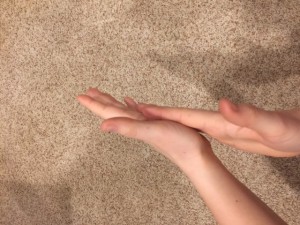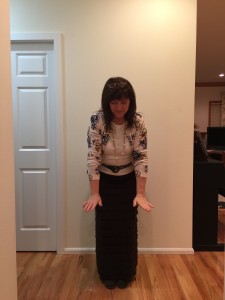
“Here’s the beat. Can your hands follow my hands to tap the beat?”

“Now let’s put it into a patsch.” (Tapping the palms of your hands on your thighs.) Patsch, patsch, patsch, patsch. Begin to sing the song. Halfway through the song, call out “Freeze!”
“We were just keeping the beat of this song. The rhythm of the song is different. It is like clapping the words of the song.” (For younger children, I liken it to capturing the words as they come out of my mouth. I actually put my hands up by mouth and “clap” the words as they come out.) “Follow my hands as we clap the rhythm of the song.” Sing the song, starting where you stopped earlier, and clap the rhythm.
“Which of you think that you can come up and lead tapping the beat?” Choose some children. (If you are working with younger children, also a choose a teacher to come up as a support for them.) “Who can come and help me clap the rhythm over here on this side?”
“This side of the room are the beat keepers. This side of the room are the rhythm keepers. Ready? Beat keepers you start us off. Patsch, patsch, patsch, patsch…” (Get the beat going first.) “Rhythm keepers, let’s clap the rhythm of the song.” Begin to sing and clap the song, while the other half of the room patsches the beat.
When you finish the song, say, “Switch! This side of the room now does the beat, and this side claps the rhythm. Beat keepers, here we go!” (You may need to signal to the other side of the room when to start singing the song and clapping the rhythm. For sure sing with them.)
Extender for Older children:
“Now I challenge you to patsch the beat with one hand, and patsch the rhythm with the other hand. It will look like this…” (Demonstrate by singing the first line of the song, patsching the beat with one hand, and patsching the rhythm with the other hand. I always have to practice this at home!<grin>)
Feeling both the steady beat of the song, and the rhythm of the song strengthens the song in the kinesthetic memory (which is a long term memory and often stronger than our conscious memory). The children are active, participating, and engaged. And it is fun!

KellyAnne
This is great! And just tricky enough to keep the older kids engaged. 🙂 I am going to use it for reviewing “Love at Home”.
Anette
I love this idea, but sadly I’m finding it impossible to patsch the beat and the rhythm at the same time. I’m sure I’ll have children that struggle with this as well, do you have any suggestions that could help those who find this difficult, to succeed?
Sharla Dance
Dear Anette, I smiled as I read this because it took months of practice on my part to do a beat in one hand and the rhythm in the other hand! Until I got to that point, I have half of the room do the beat lead by a child or teacher, and the other half do the rhythm with me leading. Then we will switch. I do give everybody a chance to do both at one point, but we usually end up laughing as we get lost! Thanks for asking.